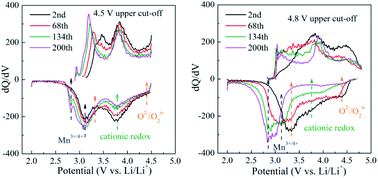Stabilizing the cationic/anionic redox chemistry of Li-rich layered cathodes by tuning the upper cut-off voltage for high energy-density lithium-ion batteries†
Abstract
Cumulative cationic/anionic redox reactions boost the reversible capacity of Li-rich layered oxides (LLOs) to 300 mA h g−1. However, the voltage/capacity fade is a major obstacle to the application of LLOs in lithium-ion batteries (LIBs). Here a paradigm shift toward tuning the charging voltages, namely a low upper cut-off voltage of 4.5 V (vs. Li/Li+) after an initial activation at 4.6 V, is proposed and the effects of cut-off voltages (4.8 V and 4.5 V) on the stability of cationic/anionic redox chemistries along with structural evolution are also revealed. It is demonstrated that the reversibility of cationic/anionic redox processes can be significantly improved at the low cut-off voltage compared with that at 4.8 V. The structural transitions from the layered to the rock-salt phase along with the valence decrease of Mn ions are consequently mitigated. As a result, the LLOs exhibit a very low capacity/voltage fade of only 4.8%/7.8% after 200 cycles at 0.5C and superior rate capability (195 mA h g−1 at 5C). Additionally, full cells composed of the LLO cathode and a mesocarbon microbead anode show a high energy density exceeding 300 W h kg−1 and improved cycling/voltage stability. This strategy provides a simple and efficient method to stabilize the cationic/anionic redox chemistries of LLOs and thus promotes their practical applications in high energy-density LIBs.



 Please wait while we load your content...
Please wait while we load your content...